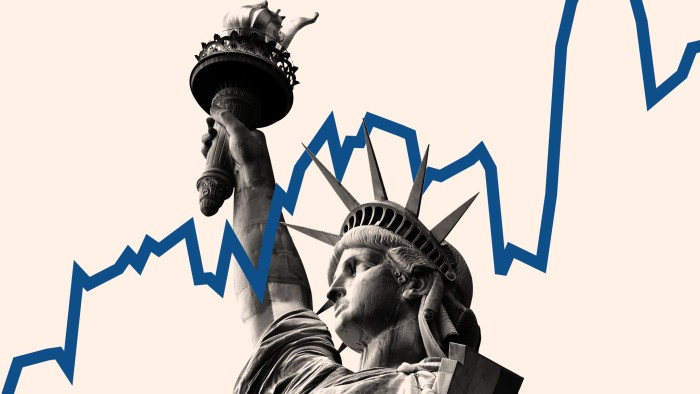Unlock the White House Watch newsletter for free
Your guide to what the 2024 US election means for Washington and the world
Tina is back in global markets. But she’s had a makeover. In the past, Tina — or There Is No Alternative to give the full name — was a reference to the idea that investors had no choice but to buy stocks.
In the low inflation, low interest rate era, developed-market government bonds — traditionally the bedrock of any mainstream portfolio — were a dud. Fund managers had no alternative to venture in to stocks instead.
Now Tina refers to the growing perception among fund managers that there is no alternative to the US, in any asset class. Big investors are having a really hard time articulating a strong case to put outsized funds to work anywhere else.
This is despite deep unease about what Donald Trump will do when he is back in the White House from January next year. In public, fund managers say all the right, polite, diplomatic things: that Trump’s conclusive second election win marks a triumph of American democracy, and that his agenda is unashamedly pro-growth. What is good for the US is good for the rest of the world. Markets are joyfully humming that tune, sending stocks sailing higher.
In private, though, the commentary is much more nervy. At a series of recent get-togethers with senior investors from a range of large investment houses, some pretty extreme analysis has cropped up. The potential risk to the independence of the Federal Reserve, either directly or through presidential undermining of its authority on social media, poses a small but genuine risk of irreversible damage to US institutions, generating an “end of empire” feeling, as some put it to me this week.
The tired old argument of the dollar losing at least some of its global reserve status through institutional deterioration, fiscal incontinence or both, is rearing its ugly head again. The icing on the cake is the preponderance of crypto bros around the president-elect, suggesting to mainstream investors a profound unseriousness about economic policy.
The worst-case scenario used to be the White House trying to meddle with the Fed. Now another contender is that it will dabble in crypto. No one knows how or whether that might affect government bonds and the dollar, but everyone agrees it introduces needless uncertainty. As one chief investment officer put it to me: “Nothing is not worrying”.
But what does everyone intend to do about all this? Load up on even more US assets, of course. For all the concern about fiscal policy under the Trump 2.0 administration, US government bonds remain the deepest, most liquid and most reliable asset class on earth. Even a homegrown institutional crisis of some kind — again, a tail risk but a serious one — would almost certainly prompt more buying of Treasuries. The dollar is still the best place to hide in an emergency.
The inflation threat to Treasuries through Trump’s proposed combination of large import tariffs, the deportation of migrant labourers and a variety of tax cuts, is real. A buyers’ strike on Treasuries if inflation expectations become unanchored and borrowing balloons — a “Liz Truss moment” as it is widely known — is a serious possibility. But the timing of such a shock is impossible to call.
Meanwhile, as America sucks growth away from the rest of the world with trade tariffs, the case for US stocks over Europe or Asia is just overwhelming. This, of course, is America’s famed exorbitant privilege at work. A country that houses the world’s reserve currency has infinitely more wriggle room for radical policy than any other.
Imagine, as one senior investor put it to me this week, that an emerging market nation had gone down this path, electing a bombastic strongman president with a spicy legal history pledging to blow out fiscal deficits and embrace a combination of high trade tariffs and a weak currency. Its bonds, currency and stocks would have cratered.
Not so, for the mighty US of A. Yes, its government bonds have weakened. There’s a note of jitters about fiscal deficits there but some of that is also a reflection of expectations that growth will accelerate. And at the same time, stocks have pushed higher. This is a break from the norm — typically an ascent in bond yields on the scale that we have seen since just before the November 5 election would be associated with a sizeable drop in stocks. It all points to “ebullience” and “animal spirits”, as Goldman Sachs’ David Kostin put it during an event this week.
At this most wonderful time of the year — outlook season — now in full swing at both banks and investment houses, the message is consistent: keep leaning in to US stocks. Europe is unlikely to mount a serious challenge, and China, already on the ropes, will feel the pain from the tariffs that Trump is determined to inflict. It is hard to imagine a Chinese currency devaluation large enough to mask that impact.
A reset here would require one of two things: a catch-up in the rest of the world, perhaps through a serious European crisis response, or a major screw-up from the US that generates enough of an economic shock to knock the stock market off its perch. But the bar for both of those is very high. The US remains the luckiest nation on earth, and Tina is on its side.
Read the full article here

